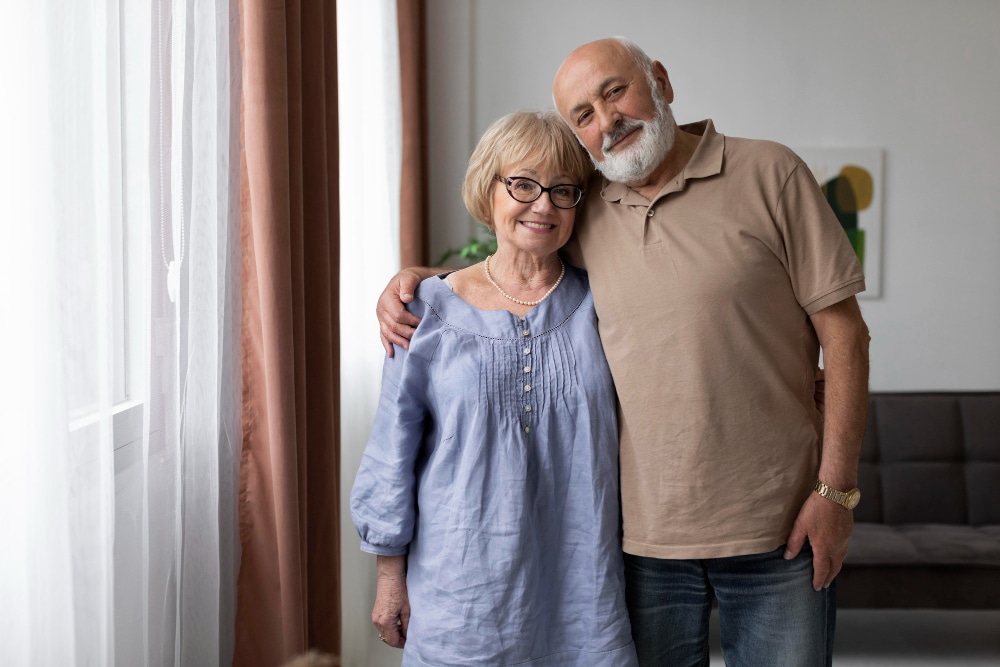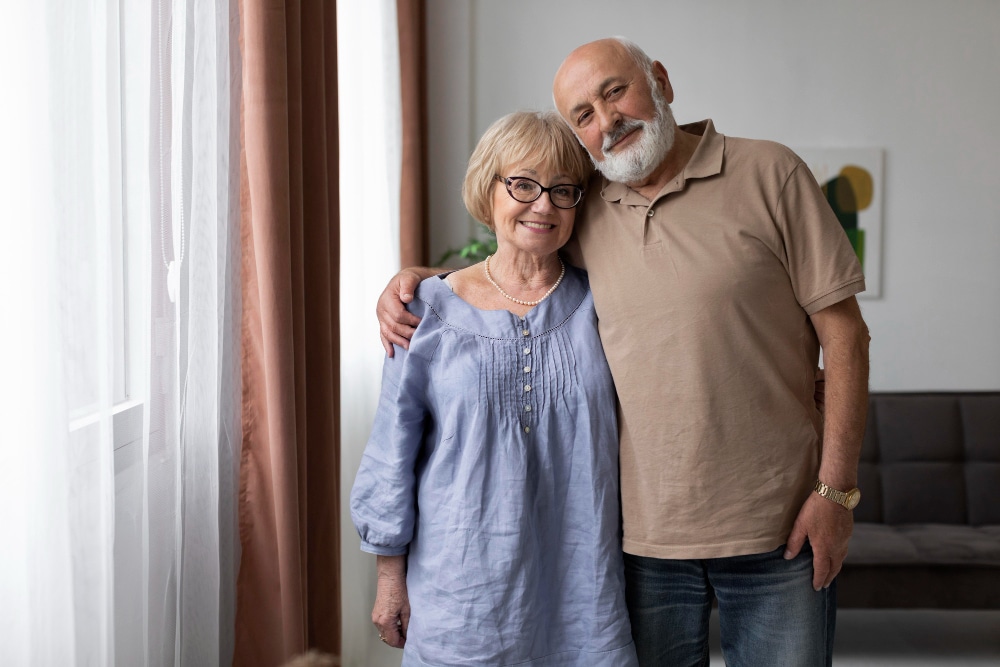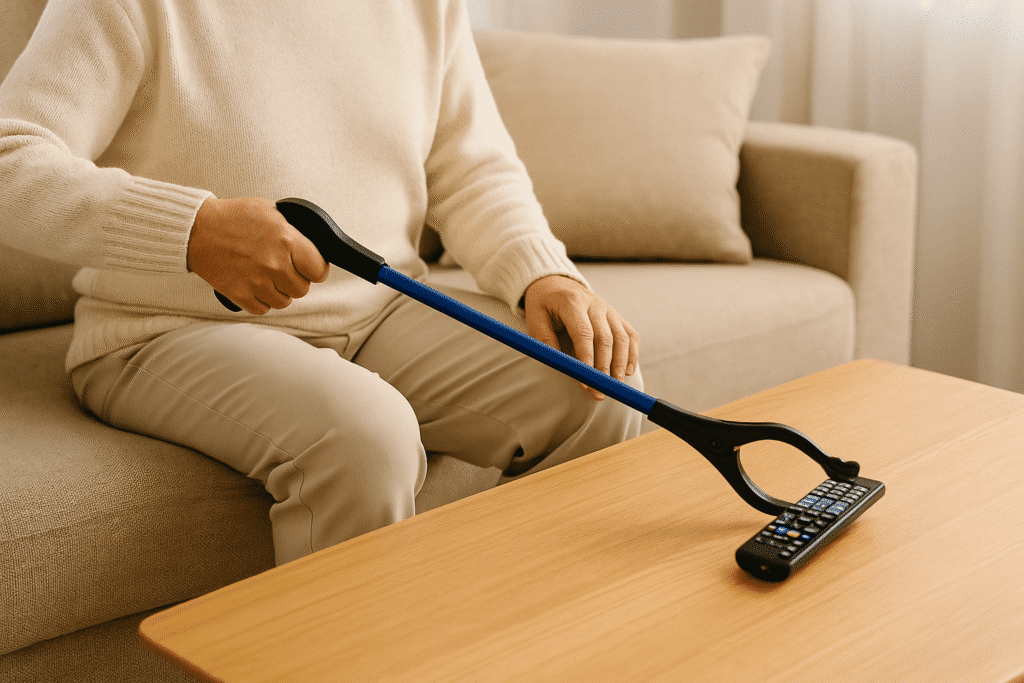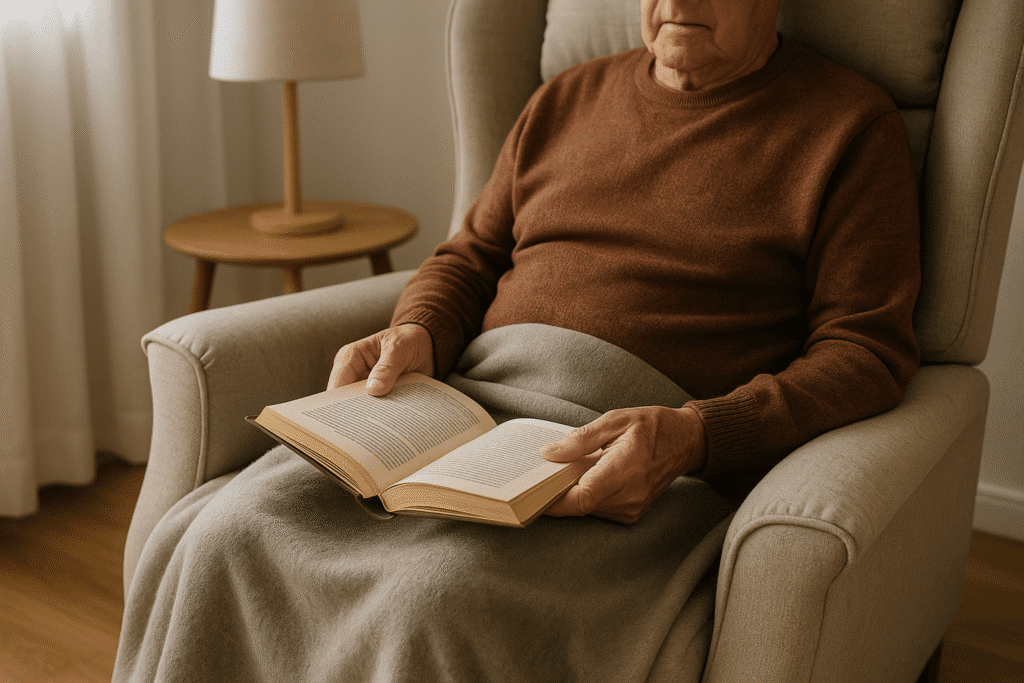Getting a good night’s sleep becomes harder as we age, especially when back pain starts to interfere. For many older adults, finding the right position can make all the difference.
Adjustable beds are becoming a popular choice for seniors with back problems because they provide customizable comfort and better spinal support.
Key Summary:
- Adjustable beds can relieve back pain by supporting the spine’s natural curve and reducing pressure points.
- Elevating the head and legs improves circulation, reduces swelling, and eases discomfort.
- Seniors find it easier and safer to get in and out of bed thanks to adjustable height and recline options.
- The right model can enhance independence, comfort, and sleep quality for older adults with chronic back pain.
Why Back Problems Are Common in Older Adults
Back pain is extremely common among seniors because of natural wear and tear on the spine. As we age, the discs between our vertebrae lose flexibility and cushioning, which can lead to stiffness, inflammation, or nerve pressure.
This makes even simple movements, like bending, sitting, or lying flat, uncomfortable.
In fact, studies show that nearly 40% of Americans aged 65 and older have at least one disability, and most report difficulty walking or climbing stairs.
Weak muscles, arthritis, and postural changes all add stress to the back, especially when the body doesn’t have proper nighttime support.
From my own experience working with older adults, I’ve seen how many wake up feeling sore simply because their mattress doesn’t align with their spine.
The right bed setup can be one of the easiest, most overlooked ways to reduce daily pain and improve sleep quality.
Are Adjustable Beds Good for Seniors with Back Problems?
Yes, adjustable beds can be very good for seniors with back problems because they allow users to raise or lower the head and legs to find the most comfortable position. This reduces spinal pressure, promotes healthy circulation, and helps maintain a neutral posture—all key for back pain relief.
Unlike flat mattresses, adjustable beds support the body’s natural curves, making it easier for seniors to rest without straining their lower back.
Many older adults find relief by sleeping slightly inclined, which takes pressure off the lumbar spine and helps them get out of bed more easily in the morning.
In my experience, adjustable beds often restore a sense of independence. Seniors who struggled to turn or sit up unassisted suddenly find they can do so with the push of a button.
That confidence, combined with less pain, can truly improve one’s quality of life.
How Adjustable Beds Help with Back Pain
Adjustable beds help relieve back pain by improving posture, reducing pressure points, and promoting circulation during rest. Here’s how each feature makes a difference:
1. Support Natural Spine Alignment
The spine has three natural curves, neck, mid-back, and lower back, that need even support during sleep. Adjustable beds let you raise your upper body and legs to match this natural shape.
This position helps the muscles relax and keeps the spine aligned, preventing the “flattening” that often causes morning stiffness.
For seniors with conditions like arthritis or scoliosis, even small adjustments can make a big difference in comfort. I’ve seen people go from waking up in pain every day to finally feeling rested after switching to an adjustable base.
2. Reduce Spinal Pressure and Pain Points
Lying flat can cause the heaviest parts of the body, like the hips and shoulders, to sink too deeply, putting pressure on the spine.
By slightly elevating the knees or head, adjustable beds redistribute body weight more evenly.
This reduces lower back strain and can ease symptoms of herniated discs or degenerative disc disease.
It’s a bit like sitting in a recliner that perfectly supports your back; the same idea applies in bed, only now it’s designed for long hours of sleep.
3. Improve Circulation and Relaxation
Many seniors struggle with swelling in the legs or poor blood flow due to limited mobility. Elevating the feet helps blood return to the heart more easily, reducing discomfort and promoting overall relaxation.
The “zero-gravity” position (where both head and legs are slightly raised) is especially effective for relieving pressure across the entire body.
Some adjustable beds even include gentle massage features that stimulate circulation and ease muscle tension, something that can feel therapeutic after a long day.
4. Easier Mobility and Transfers
Getting in and out of bed is one of the top moments when seniors risk falls. Adjustable beds can lift the upper body, allowing users to sit up safely before standing.
This simple feature promotes independence and reduces the need for caregiver assistance.
Given that over one in four seniors experience a fall each year, according to the CDC, any product that improves safety and reduces strain deserves serious consideration.
Adjustable beds don’t just relieve pain; they make everyday living easier and safer, too.
Conditions That May Benefit Most
Adjustable beds can help a wide range of back-related and age-related conditions by easing pressure and improving spinal alignment. Here are some of the most common issues that benefit the most:
- Spinal Stenosis: Seniors with spinal stenosis often feel better when leaning slightly forward, as it opens up space in the spinal canal. Sleeping in a reclined position helps relieve that nerve pressure and discomfort.
- Osteoarthritis: Gentle elevation of the head and knees can reduce joint compression and stiffness, leading to fewer painful mornings.
- Degenerative Disc Disease: Raising both the upper body and legs reduces tension on the lower spine and helps prevent disc irritation.
- Spondylolisthesis: An inclined position with knees slightly bent eases the forward slip of vertebrae, providing better rest and less pain.
- Post-Surgery Recovery: After spinal or hip surgery, an adjustable bed allows seniors to find stable, comfortable positions without straining healing tissues.
- Poor Circulation or Swelling: Elevating the legs promotes blood flow and reduces fluid buildup in the feet and ankles, especially beneficial for seniors with edema or diabetes.
Key Features to Look for in an Adjustable Bed
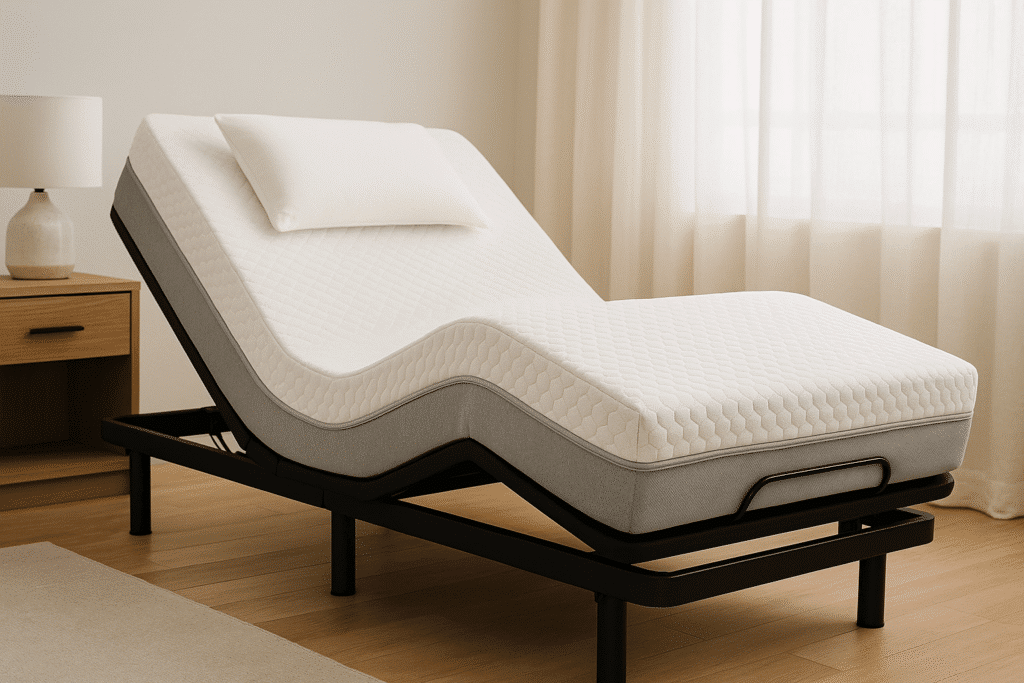
When choosing an adjustable bed for seniors, look for features that promote both comfort and long-term safety. The right design can make daily use simpler, safer, and far more effective for pain relief.
Head and Foot Elevation
This is the core feature of every adjustable bed. The ability to raise the head helps relieve pressure on the neck and lower back, while elevating the legs reduces swelling and improves circulation.
For many seniors, even a small angle adjustment can transform how their back feels in the morning.
Zero-Gravity Position
The “zero-gravity” preset gently raises both the head and legs to mimic a weightless position, where pressure is evenly distributed across the body.
This position reduces stress on the spine and joints and promotes deep relaxation. It’s especially effective for chronic back pain or arthritis.
Lumbar Support Adjustment
Some advanced models include a separate lumbar control to fine-tune support in the lower back area. This feature helps prevent sagging and provides extra stability where it’s needed most.
Seniors with chronic lumbar pain or sciatica often find this setting particularly helpful.
Massage and Vibration Settings
Gentle massage functions can improve blood flow, relax tight muscles, and make it easier to fall asleep.
While it’s not a medical treatment, this feature can help ease tension after a long day of sitting or standing. Many seniors also find it comforting for restless legs or mild joint pain.
Read more: How to relieve sitting pain for seniors
Easy-to-Use Remote and Preset Memory
A simple, well-lit remote is essential for seniors with limited dexterity or eyesight.
Some models let you save favorite positions as presets, so you can return to your preferred setting with one button, handy for nightly routines.
Sturdy Frame and Quiet Motor
Safety and durability matter as much as comfort. Look for a strong steel or reinforced frame that can support body weight evenly.
Quiet, smooth motors are ideal for those who adjust positions during the night without disturbing a partner.
Tips for Choosing the Right Model
Buying an adjustable bed isn’t just about comfort; it’s about matching the design to your specific needs, space, and health conditions. Here are a few helpful tips:
- Test before you buy: If possible, visit a store to try different incline angles and controls to find what feels best for your back.
- Check mattress compatibility: Most adjustable bases work best with memory foam or hybrid mattresses that can flex without losing support.
- Look for safety features: Non-slip surfaces, locking wheels, and power backup options are important for seniors’ safety.
- Prioritize usability: Choose a remote with large buttons or a mobile app if hand strength or vision is limited.
- Consider split models for couples: Split king or queen bases let each person adjust their side independently for comfort.
- Review warranty and service: Quality adjustable beds usually come with 10-year or longer warranties on motors and frames, essential for long-term use.
- Mind the assembly: Some beds are heavy or complex to set up. Check if white-glove delivery or in-home assembly is included.
A thoughtful purchase not only relieves back pain but also adds safety, independence, and confidence to daily living, making it a smart upgrade for aging in place comfortably.
For a full list of our hands-on reviews, visit our complete guide to the best adjustable beds for seniors.
Potential Drawbacks to Keep in Mind
While adjustable beds offer excellent comfort and support, they may not be the perfect fit for everyone. It’s important to weigh the pros and cons before investing in one.
- Higher upfront cost: Quality adjustable beds can be more expensive than traditional frames or mattresses.
- Heavy and difficult to move: The motorized base can make the bed bulky, especially during setup or room rearrangement.
- Maintenance needs: Electric parts like motors and remotes may require occasional servicing or replacement.
- Power dependency: In the event of a power outage, some models can’t adjust until electricity is restored.
- Mattress compatibility issues: Not all mattresses flex properly, memory foam or hybrid models work best.
- Potential overuse of incline: Sleeping with too steep an angle for long periods can sometimes strain the neck or hips.
Who Should Avoid Adjustable Beds
Not everyone will find adjustable beds suitable. In general, people who must sleep flat for medical reasons or have certain spine conditions should avoid adjustable beds.
For instance, seniors recovering from specific spinal fusions or surgeries may be instructed by their doctor to maintain a flat, stable position for healing.
In such cases, a standard orthopedic mattress might be better. Likewise, individuals with severe kyphosis (a forward-curved spine) can find it uncomfortable to recline for long periods.
It’s always best to speak with a healthcare professional or physical therapist before making the switch. They can help you determine the safest sleep setup for your condition.
In my years working with seniors, I’ve found that a quick medical consultation often prevents future discomfort and ensures the investment truly supports your health.
Final Words
Adjustable beds can be a life-changing upgrade for seniors struggling with back pain, poor circulation, or mobility challenges.
By offering personalized support and easier movement, they help promote restful sleep and greater independence, two things that greatly enhance quality of life.
While they do come with some extra cost and care requirements, the comfort and safety benefits often outweigh those concerns for most older adults.
If back pain or stiffness has been disrupting your nights, an adjustable bed might be one of the most practical and rewarding improvements you can make to your daily comfort.
FAQs
Are adjustable beds safe for seniors to use every night?
Adjustable beds are safe for nightly use when properly set up. They can even improve safety by helping seniors sit up and get out of bed more easily, reducing fall risk.
Can adjustable beds really help with back pain?
By allowing you to elevate the head and legs, adjustable beds reduce pressure on the spine and help maintain a natural curve. This can ease discomfort and support better sleep posture.
Do adjustable beds work with any mattress?
Not all mattresses are compatible. Memory foam, latex, or hybrid mattresses are best since they can bend and move with the adjustable base without losing support.
Are adjustable beds noisy when adjusting positions?
Modern adjustable beds use quiet motors designed for smooth operation. Higher-end models are nearly silent, so you won’t disturb your partner if you change positions during the night.
How long do adjustable beds usually last?
A quality adjustable bed typically lasts around 8–15 years, depending on the brand and how often it’s used. Choosing a model with a strong warranty ensures longer peace of mind.
Can using an adjustable bed improve sleep quality?
By allowing you to find a position that reduces pain and supports your spine, adjustable beds help you fall asleep faster and stay asleep longer, especially if you’ve been waking from back discomfort.
Mark has over 10 years of hands-on experience in senior care. He founded ElderSavvy to provide honest, easy-to-follow advice on tools that support comfort, safety, and independence. Mark oversees all content and product reviews, guided by insights from caregivers, health professionals, and real-life use.



